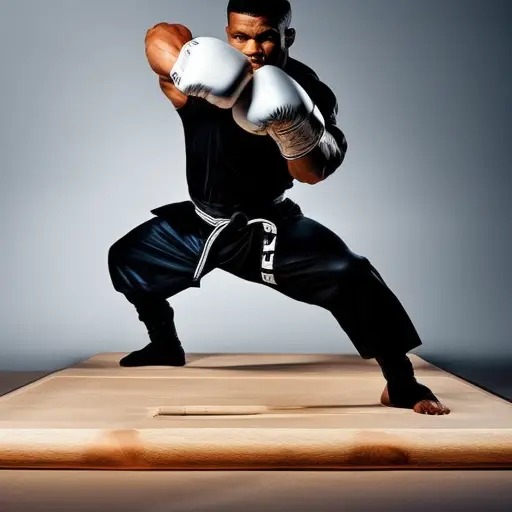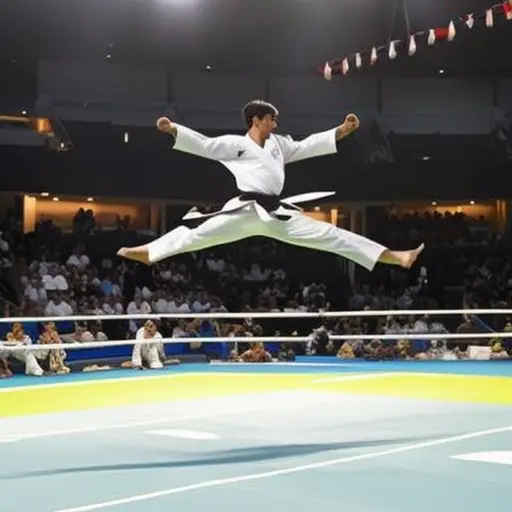Evaluating Progress: Setting and Achieving Taekwondo Goals

In the world of taekwondo, progress is like a journey, with each step leading to new heights of skill and achievement. Just as a compass guides a traveler, setting and achieving goals in taekwondo serves as a guiding force, directing practitioners towards success.
In this article, we will explore the art of evaluating progress in taekwondo, uncovering the strategies and techniques that will help you set realistic goals, measure your growth, and overcome obstacles on your path to greatness.
The Importance of Goal Setting in Taekwondo
One of the key aspects of success in Taekwondo is the importance of setting clear and measurable goals. The psychology of goal setting in Taekwondo plays a crucial role in an athlete’s performance and development. When athletes set goals, they create a clear vision of what they want to achieve and the steps they need to take to get there. This helps them stay focused, motivated, and committed to their training.
In Taekwondo competitions, goal setting is particularly beneficial. Setting specific goals for each competition allows athletes to channel their energy and efforts towards achieving those targets. It provides them with a sense of direction and purpose, enhancing their mental preparedness and overall performance.
Moreover, goal setting in Taekwondo competitions helps athletes maintain a positive mindset. By setting achievable and realistic goals, athletes can boost their self-confidence and self-belief. This positive mindset gives them the mental edge needed to overcome challenges and perform at their best.
Reflecting on Your Progress: Assessing Your Taekwondo Skills
Assessing your Taekwondo skills is an essential part of reflecting on your progress and identifying areas for growth. By measuring your skill improvement, you can gain a clear understanding of your strengths and weaknesses.
This self-assessment helps you set realistic goals and develop a targeted training plan to enhance your overall performance in Taekwondo.
Measuring Skill Improvement
When evaluating your progress in Taekwondo, it is important to reflect on and measure your skill improvement through the assessment of your Taekwondo skills. Measuring improvement and tracking progress allows you to identify areas of strength and areas that need improvement. By regularly assessing your skills, you can set specific goals and work towards achieving them. One effective way to measure skill improvement is by using a skill assessment table, which helps you track your progress over time. Here is an example of a skill assessment table:
| Skill | Current Level | Target Level |
|---|---|---|
| Kicks | Beginner | Intermediate |
| Blocks | Intermediate | Advanced |
| Forms | Advanced | Master |
Identifying Areas for Growth
Identifying areas for growth and developing a comprehensive understanding of your progress in assessing your Taekwondo skills are crucial steps towards achieving your goals in this martial art.
To identify areas for improvement, it is essential to engage in self-assessment techniques. One effective technique is to record and review your training sessions or competitions. By watching yourself perform, you can identify strengths and weaknesses in your techniques, footwork, and timing.
Another technique is to seek feedback from your instructor or a more experienced practitioner. They can provide valuable insights and guidance on areas that need improvement.
Additionally, self-reflection and analysis after each training session can help you identify patterns or recurring mistakes that need attention.
Strategies for Effective Goal Evaluation in Taekwondo
One of the key strategies for effective goal evaluation in Taekwondo is tracking goal progress.
By regularly monitoring your progress, you can determine if you are on track to achieving your goals or if adjustments need to be made.
This involves keeping a record of your training sessions, competition results, and skill development, allowing you to assess your performance and make informed decisions about your goals.
Tracking Goal Progress
To ensure effective goal evaluation in Taekwondo, it is essential to implement strategies for tracking goal progress. Tracking progress allows practitioners to stay motivated, identify areas for improvement, and measure their overall performance.
Here are three strategies for tracking goal progress in Taekwondo:
-
Regular Assessments: Conduct regular assessments to evaluate your current skill level and track improvements over time. This can include performance evaluations, belt tests, or sparring sessions.
-
Goal Setting and Monitoring: Set specific, measurable, achievable, relevant, and time-bound (SMART) goals. Regularly monitor your progress towards these goals to ensure you are on track.
-
Journaling and Reflection: Keep a training journal to record your workouts, techniques practiced, and areas of improvement. Reflect on your progress and make adjustments to your training plan as needed.
Adjusting Goals Accordingly
In order to effectively evaluate and adjust goals in Taekwondo, it is important to implement strategies that allow for ongoing reflection and adaptation.
Adjusting goals is a crucial part of the goal-setting process in Taekwondo, as it enables practitioners to stay on track and make necessary modifications to their original objectives.
One strategy for adjusting goals is to regularly reevaluate progress. This involves taking the time to objectively assess current performance and determine if any changes need to be made to the original goals. It is important to consider factors such as skill level, physical capabilities, and training intensity when reevaluating progress.
Additionally, seeking feedback from instructors or coaches can provide valuable insights and guidance for adjusting goals accordingly.
Setting Realistic and Achievable Taekwondo Goals
Setting attainable and reasonable taekwondo goals is crucial for progress and success in the martial art. By setting realistic goals, practitioners can stay motivated and focused, leading to greater achievements and personal growth. Here are three key reasons why setting achievable taekwondo goals is essential:
-
Maintaining motivation: Realistic goal setting ensures that practitioners remain motivated throughout their taekwondo journey. When goals are within reach, individuals are more likely to stay committed, push themselves, and overcome challenges.
-
Tracking progress: Setting achievable milestones allows practitioners to track their progress effectively. By breaking down long-term goals into smaller, manageable targets, individuals can measure their advancements and celebrate each milestone achieved.
-
Building confidence: Attaining realistic goals boosts self-confidence and reinforces the belief that progress is possible. As practitioners reach their targets, they gain a sense of accomplishment, which bolsters their confidence and encourages them to set higher aspirations.
Techniques and Methods to Help You Reach Your Taekwondo Goals
One effective technique for reaching taekwondo goals is by incorporating various training methods and drills into your practice routine. Effective training is essential for improving your skills and achieving your desired goals in taekwondo. By utilizing different training methods, such as strength and conditioning exercises, flexibility training, and specific techniques practice, you can enhance your overall performance and progress in the sport.
Mental preparation is equally important in reaching your taekwondo goals. Developing a strong mindset and mental resilience can help you overcome challenges and perform at your best. Techniques such as visualization, goal setting, and positive self-talk can be incorporated into your training routine to enhance your mental focus and preparation.
In addition to training methods and mental preparation, it is crucial to have a well-structured training plan. Setting specific and measurable goals, breaking them down into smaller achievable steps, and tracking your progress can keep you motivated and on track towards reaching your taekwondo goals.
Furthermore, seeking guidance from experienced coaches and trainers can provide valuable insights and feedback to improve your technique and training regimen. Regularly assessing your strengths and weaknesses and adjusting your training accordingly can help you optimize your performance and accelerate your progress in taekwondo.
Staying Motivated and Overcoming Challenges in Taekwondo Goal Achievement
Maintaining motivation and overcoming challenges is crucial for achieving one’s taekwondo goals. Staying motivated in taekwondo can be challenging, especially when faced with obstacles along the way. However, with the right mindset and strategies, it is possible to stay motivated and overcome these challenges.
Here are three effective ways to stay motivated and overcome challenges in taekwondo goal achievement:
-
Set specific and achievable goals: By setting clear and realistic goals, you can maintain focus and track your progress. Break down your larger goals into smaller, more manageable ones, and celebrate each milestone you achieve.
-
Find a support system: Surround yourself with like-minded individuals who share your passion for taekwondo. Join a taekwondo club or find a training partner who can provide encouragement and support during challenging times.
-
Embrace failure and learn from it: Don’t let setbacks discourage you. Instead, view them as opportunities for growth and improvement. Learn from your mistakes, analyze what went wrong, and make adjustments accordingly.
Frequently Asked Questions
How Long Does It Typically Take to Achieve a Black Belt in Taekwondo?
The average time it takes to achieve a black belt in taekwondo can vary depending on factors such as training intensity, dedication, and natural ability. It typically takes several years of consistent practice and effort to reach this level of proficiency.
Are There Any Specific Age Limitations for Setting and Achieving Taekwondo Goals?
Age limitations for setting and achieving taekwondo goals vary, with suitable age groups typically starting as young as 4 years old. It is important to consider physical and mental readiness when determining appropriate age for training and progression in taekwondo.
What Are Some Common Obstacles That People Face in Achieving Their Taekwondo Goals?
Overcoming challenges and mental barriers are common obstacles that individuals face in achieving their taekwondo goals. These obstacles may include lack of self-confidence, fear of failure, and difficulty in maintaining motivation.
Can You Provide Examples of Short-Term and Long-Term Goals That Are Commonly Set in Taekwondo?
Examples of short-term goals in taekwondo include mastering a specific technique or earning a new belt rank within a few months. Long-term goals may involve competing at a national level or achieving a black belt after years of training. Goal setting is crucial in taekwondo training as it provides direction, motivation, and a sense of accomplishment.
Are There Any Specific Techniques or Methods That Can Help Improve Focus and Discipline in Taekwondo Training?
Improving concentration and enhancing self-control are essential in taekwondo training. Techniques such as meditation, mental visualization, and breaking down training sessions into focused intervals can help individuals develop these skills.
Conclusion
In conclusion, goal setting and evaluation play a crucial role in achieving success in taekwondo. By reflecting on your progress, setting realistic goals, and utilizing effective techniques and methods, you can steadily improve your skills and reach new heights in this martial art.
Staying motivated and overcoming challenges along the way will further contribute to your taekwondo journey. So, set your goals, work hard, and let the power of taekwondo propel you towards your dreams.





